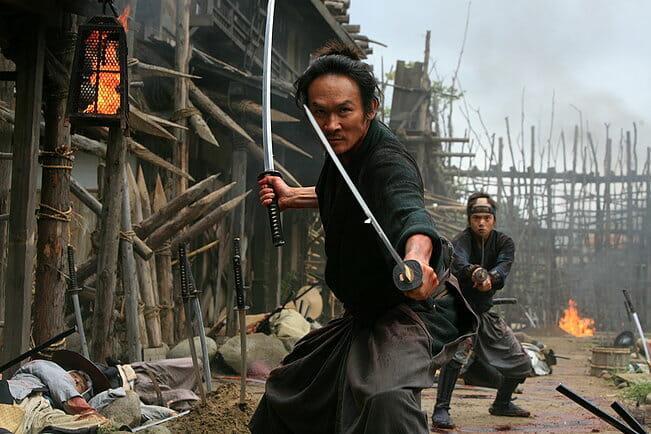Introducing Endless Mode: A New Games & Anime Site from Paste
Director: Takashi Miike
Writers: Kaneo Ikegami and Daisuke Tengan
Cinematographer: Nobuyasu Kita
Stars: Kôji Yakusho, Takayuki Yamada, Yûsuke Iseya, Gorô Inagaki
Studio/Running Time: Magnet Releasing, 126 min.
While Takashi Miike’s name here in the United States will forever by synonymous with his ultra-violent pictures like Ichi the Killer and Audition, at this point he’s worked in pretty much every genre under the sun—not a huge surprise considering that he’s likely the most prolific director of all time (IMDB; lists 83 projects he’s directed since 1991). Even so, there are still large consistencies to his pictures, which tend to boast stylistic outrageousness and shock for the sake of shock in whatever he’s doing. Expectations for a Miike picture are that you are going to see something bold and daring but that you probably didn’t want to see, and Miike seems to like it that way.
Thirteen Assassins largely diverges from the rest of Miike’s films, though, stripping away much of his stylistic excesses such that for once he delivers a nearly traditional film. In fact, it’s a remake, taking on a 1963 cruel-Jidaigeki of the same name that’s a sort of dark knock-off of Seven Samurai. In the film, after it’s clear that the emperor’s heir is an evil man, noblemen hire a group of samurai to assassinate him before his rise to power brings ruin to all of Japan. The first half of the movie is about setting up exactly how evil this man is (answer: really evil) and gathering up the 13 titular assassins who seek to be his undoing, as well as introducing us to the honorable samurai acting as the heir’s bodyguard. The second half is just one long fight.
The film’s main surprise is that aside from a few shocking moments early on, after the first 10 minutes 13 Assassinslargely plays out like a historical epic. Compositions are traditionally beautiful and stagings recognizably echo Akira Kurosawa, Masaki Kobayashi and Hiroshi Inagaki’s earlier masterworks. Even during the most violent fight scenes Miike never winks at the audience, instead playing up the full grimness of battle in an exaggerated but never over-the-top manner. And sure, at one point a stampede of flaming bulls gets unleashed, but for Miike that still counts as restrained.
The result of Miike curbing his nastier impulses is that while the film is still bloody and dark, it’s also every bit a great samurai movie. The 13 assassins are well-characterized and the lanscapes are stirring. As a whole Thirteen Assassins feels less slapdash than many of his efforts, perhaps the result of him only directing two films last year instead of six. Although its points about honor versus values can be a bit blunt, they’re still apt and Miike seems truly passionate about what’s on-screen. It’s not just a style exercise, this time there are moments of contemplation and real concern for the film’s characters and ideas.
I hesitate to make any grand statements about Miike growing as an artist because he’s always shifting and most of his pictures don’t find distribution here—case in point one of his 2011 productions is the certain-to-be-ridiculous Ninja Kids!!!. But Thirteen Assasssins feels like the work of a more mature filmmaker and perhaps the beginning of a new road for Miike, still unrestrained in its content but more considered with what that content is saying. It’s a Miike film that for once can be recommended without caveats, boldly treading new ground but also taking stock of what’s come before and not rejecting it outright.
